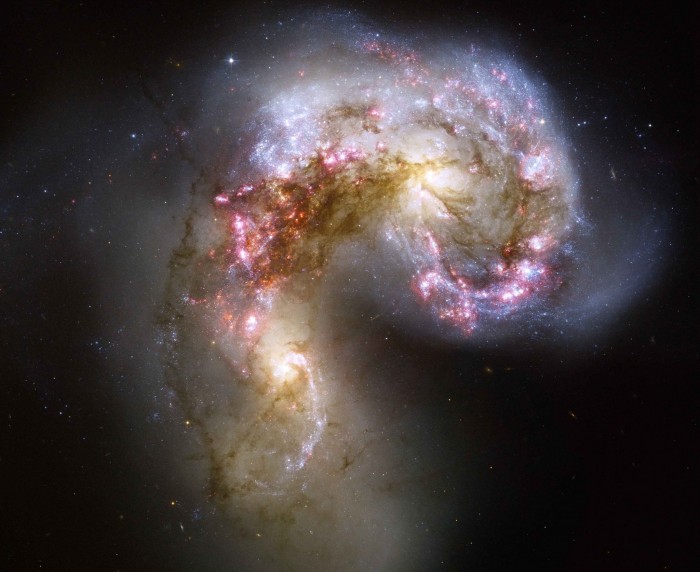This week, NASA announced the discovery of a galaxy cluster found billions of light years from Earth. The finding, published in The Astrophysical Journal, identified a unique property of the cluster, named SpARCS1049+56. It hosts what physicists call a wet merger, which is a unique type of galactic joining in the presence of hydrogen gas. In the cluster, two component galaxies at the center are joining and creating new stars. Galaxy clusters, which can consist of anywhere from fifty to a thousand galaxies, are the largest things in the universe that are bound together by gravity.
Galaxy mergers are far from rare. SpARCS1049+56, which has been nicknamed Sparky, is special because its wet merger occurred in the center of a galaxy cluster, where it was thought that there would be no gas for new stars to form. As a galaxy drifts through a large cluster to settle at the center over immense periods of time, the raw stellar material is generally stripped away, creating a too old and too resource-poor galaxy that cannot form stars.
“Usually, the stars at the centers of galaxy clusters are old and dead, essentially fossils,” explains McGill physics Professor Tracy Webb.
The cluster was discovered primarily using the Spitzer Space Telescope. This telescope scans in the infrared (IR) spectrum, enabling it to detect the radiation emitted by bright starbursts created by the galaxy merger, far above the distortion created by Earth’s atmosphere. More information about the cluster’s properties was derived from data collected by the Canada France Hawaii (CFHT) Telescope and the Keck Telescope (amongst the largest terrestrial telescopes in use) as well as scans done by the Hubble Space Telescope.
SpARCS1049+56 is unique in more than one way. Not only is it undergoing this extremely unlikely type of rebirth—creating new stars—as a result of the wet merger, but it’s doing it at an incredible rate. The merger is thought to produce well over eight hundred new stars per year. In comparison, our own galaxy, the Milky Way, only births one or two stars per year.
A tell-tale sign of new star formation is the formation of gas pockets. This phenomenon, described as by astronomers as ‘beads on a string,’ was observed by the Hubble and Spitzer telescopes.
“With Spitzer's infrared camera, we can actually see the ferocious heat from all these hot young stars,” stated Jason Surace, Senior Research Astronomer at Caltech, another coauthor of the paper.
SpARCS1049+56 is 9.8 billion light-years from earth. To put this into perspective, if Pluto were 7 μm away from the Earth (the width of a single red blood cell), the cluster would still be 133,000 km away (more than the diameter of Saturn).
But even though SpARCS1049+56 is extremely far away and very old. Also, any information we know about it ten billion years out of date, because that’s how long it’s taken light to travel the distance separating us from the galaxy cluster. However, astronomers believe that the cluster is still around today. Unlike other celestial bodies like stars and nebulae, whose expiration dates are astronomical but existent, galaxy clusters are essentially endless.
According to Webb, the fascinating galaxy wet merger that makes SpARCS1049+56 so special is by now long over, having lasted about a billion years. However, the object, now wholly merged into one gargantuan galaxy of mature stars, still very much exists and is probably one of the largest things in the universe.
“Today Sparky is probably a very massive galaxy but not one that has much going on,” said Webb.










Ten billion years, that is, not light years. Titles get monkeyed with by half a dozen people, stuff happens. Whoops. And Prof. Webb is, of course, one of the cluster’s discoverers and a lead author of the linked paper, not just some schmo we picked up to talk with about galaxies. Somehow the McGill connection got lost along the way, but it’s absolutely central that this discovery is local (group) news!